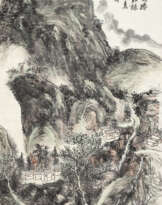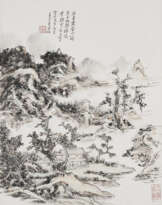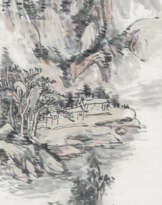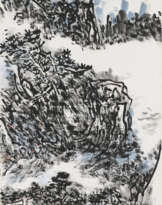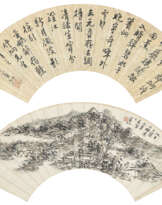ID 862635
Lot 1136 | HUANG BINHONG (1864-1955)
Valeur estimée
HKD 1 000 000 – 2 000 000
The Echo of Xishan
Scroll, mounted and framed, ink and colour on paper
98.5 x 41.3 cm. (38 3/4 x 16 1/4 in.)
Inscribed and signed, with three seals of the artist
Dated xinsi year (1941)
Dedicated to Zuofu
Provenance
Acquired directly from the artist, hence by descent.
Literature
Paintings by Huang Binhong, Ta Kung Pao, Hong Kong, May 1961, p. 48.
An Exhibition of Works by Huang Binhong Exhibition Catalogue Chronology, Hong Kong Arts Centre and the Department of Fine Arts of the University of Hong Kong, 1980, no pagination.
Chronology of Painter Huang Binhong, People’s Fine Arts Publishing House, June 1992, p. 157.
Chronology of Huang Binhong, Shanghai Painting and Calligraphy Publishing House, June 2005, pp.414-415.
Post lot text
Yang Zuofu (Yeung Chok Poo, 1896-1973) was born in Zhongshan, Guangdong province. After graduating from Guangdong University (now Sun Yat-sen University), Yang taught at the Zhongshan Military Academy for a while before moving to Guangzhou. He often travelled between Guangdong, Hong Kong and Macau for business and finally settled in Hong Kong in 1938. In the wake of the Second Sino-Japanese War, Yang moved his family to Macau before Hong Kong surrendered. The family returned to Hong Kong in 1946 and re-established their shipping and property management businesses.
Outside his successful business career, Yang Zuofu was passionate about Chinese literature and paintings. After his retirement, he frequented Luk Yu Tea House in Central and gathered with the art and literary circle to appreciate tea and discuss art. His studio, Xicha An, translated as House of Appreciating Tea, expresses his aspiration for the literati’s life. With a penchant for writing, Yang regularly contributed to Tai Kung Pao, a local newspaper. Yang became friends with many like-minded, leading figures in the arts, such as Huang Binhong, Feng Gangbai, Huang Jusu, Li Fanfu, Ren Zhenhan and Ye Wenpu.
The present collection showcases five Huang Binhong paintings and calligraphic works from Yang Zuofu’s collection. The highlight is the handscroll entitled Studio of Tea Appreciation, painted in 1939 and since then been inscribed by more than a dozen literary figures. Among them, Huang Juxu was especially noteworthy, for he was a student and good friend of Huang Binhong, who helped the artist to promote his works in Hong Kong. With the help of Huang Juxu, Yang got to know the artist and secured this commission named after his studio name. This work naturally became the first Huang Binhong painting in the Xicha An collection.
Since acquiring the handscroll, Yang Zuofu continued to collect other Huang Binhong paintings. The Studio of Tea Appreciation has accompanied the family since 1939 and has been kept safely through wartime and multiple moves by the family between Hong Kong and Macau. Two of his collected works were published in a Huang Binhong monograph by Tai Kung Pao in 1958 and 1961. These paintings have not appeared in public since then. Christie’s is honoured to present the collection and hopes it provides an opportunity for our audience to appreciate Huang Binhong’s paintings as Yang Zuofu did in his lifetime.
| Artiste: | Huang Binhong (1865 - 1955) |
|---|---|
| Style artistique: | Art moderne |
| Artiste: | Huang Binhong (1865 - 1955) |
|---|---|
| Style artistique: | Art moderne |
| Adresse de l'enchère |
CHRISTIE'S 18 Chater Road Central Hong Kong Hong Kong | ||||||||||||||
|---|---|---|---|---|---|---|---|---|---|---|---|---|---|---|---|
| Aperçu |
| ||||||||||||||
| Téléphone | +85227601766 | ||||||||||||||
| Fax | +852 2760 1767 | ||||||||||||||
| Conditions d'utilisation | Conditions d'utilisation | ||||||||||||||
| Heures d'ouverture | Heures d'ouverture
|


